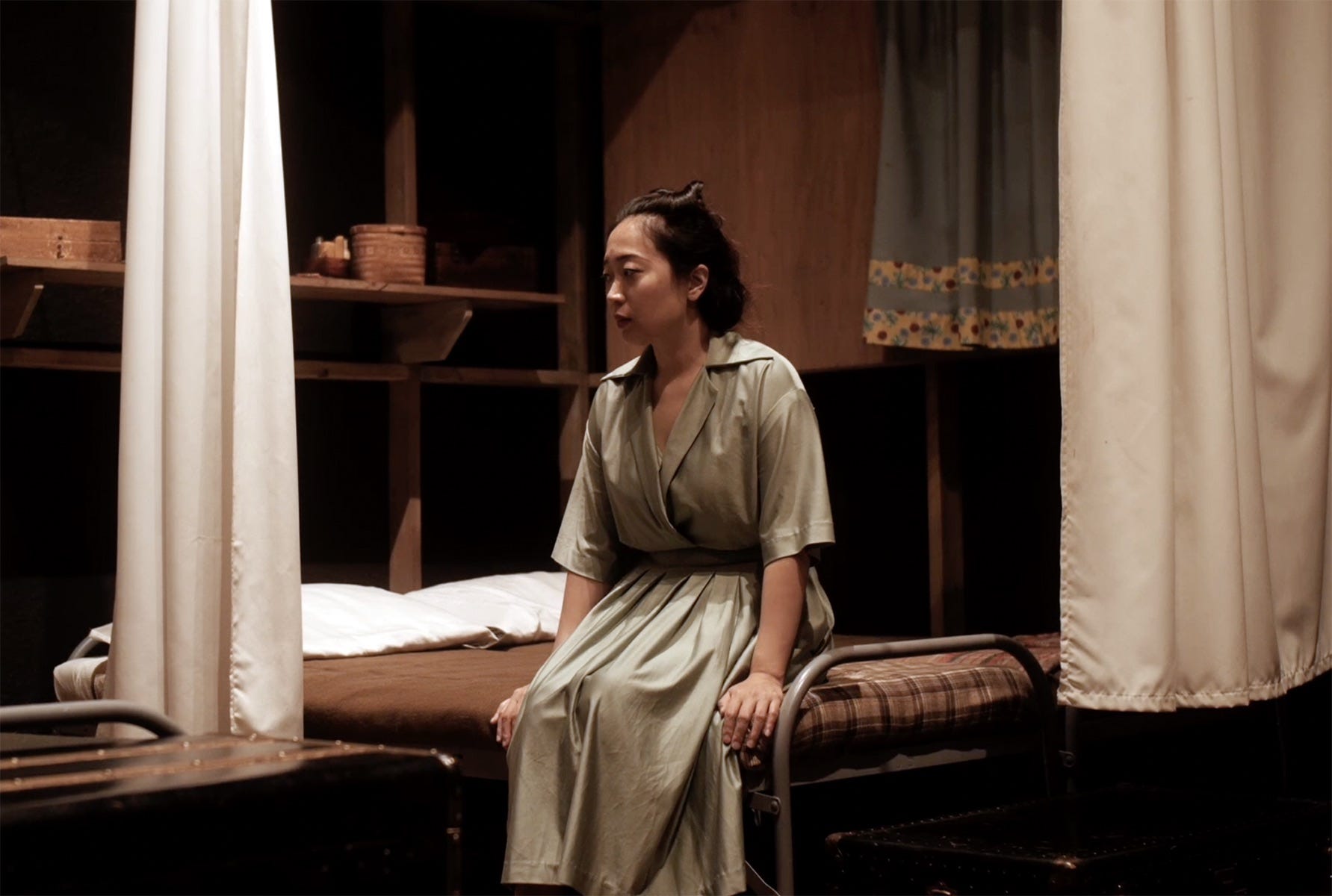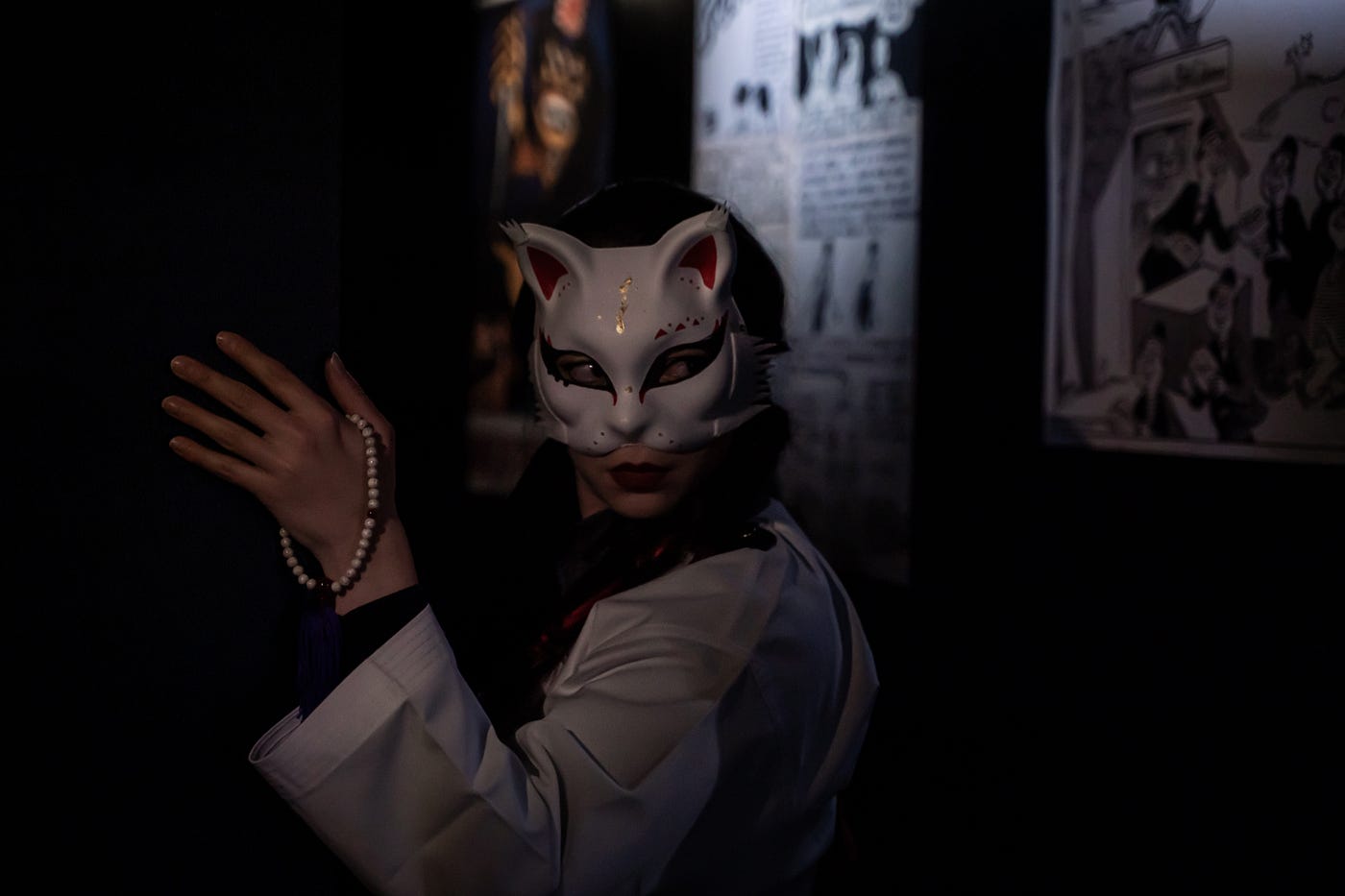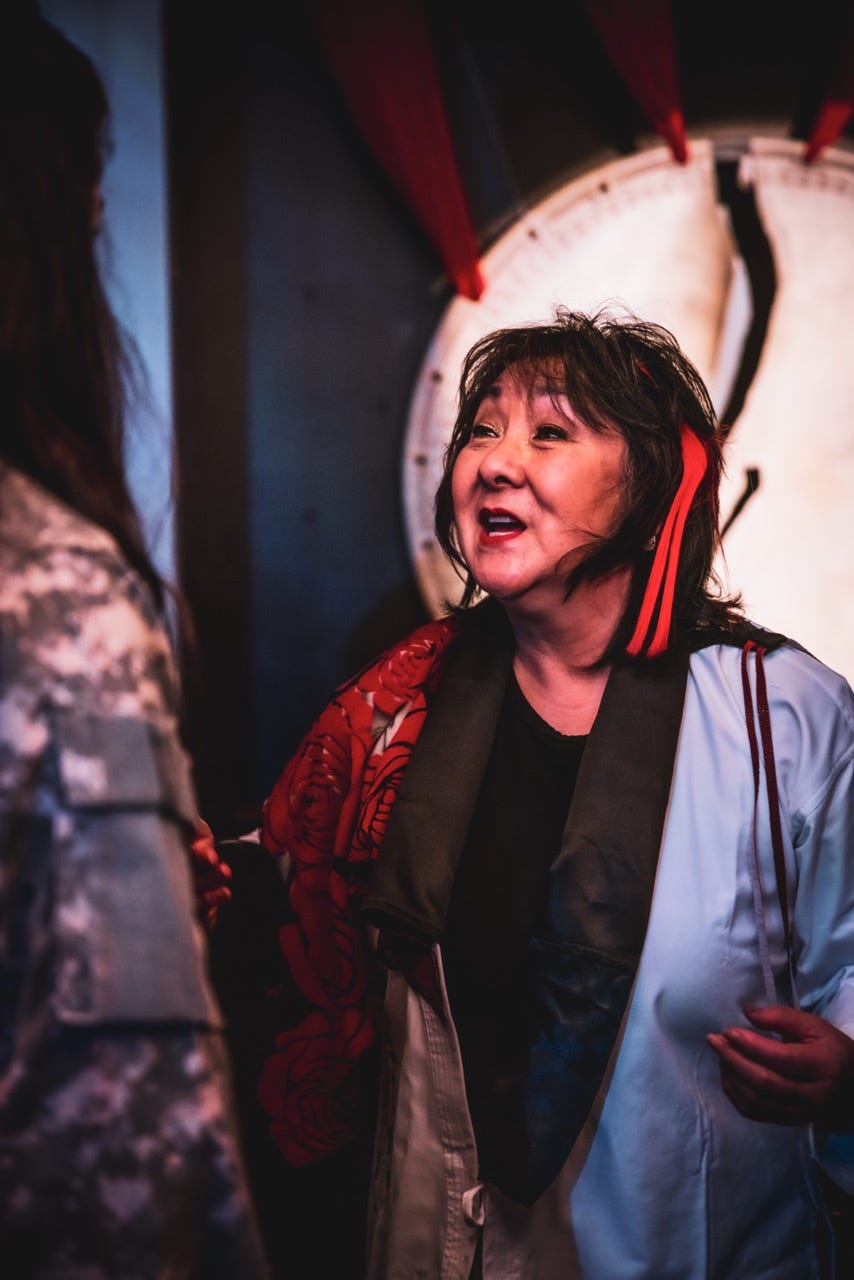The Past Holds Painful Lessons In ZOTTO (Review)
In Denver: an unflinching, experiential look at Japanese internment in WWII


My appointment with Dr. Kitsu was at 8 pm at the fictional ZOTTO Holistic Health Office inside Sakura Square, the non-fictional heart of Denver’s Japanese community. Clipboards sat on all of the waiting room chairs, each with a copy of the intake details for Miya, a fifth generation Japanese American patient at the center who we’ll meet later in our journey.
Kaibyo, a supernatural cat from Japanese folklore, welcomed us into the center by giving us warm, lavender scented hand towels and offering us small cups of warm tea to help us relax. The spirit, played by a masked performer, was timid and meek but also hospitable and playful. After watching a short video to learn more about Miya and her search for her grandmother, we moved into the next room to meet Dr. Kitsu, who set the spiritual tone for the journey we were about to embark on.
A walk down a hallway lined with posters gave a quick glimpse into the discrimination and abuse that Japanese Americans encountered after Japan’s surprise attack on Pearl Harbor in 1941. Specifically, in Colorado, the United States government incarcerated more than 10,000 Japanese Americans at the Granada Relocation Center, an internment camp in southeastern Colorado that was unofficially known as Amache, after the daughter of a Cheyenne chief. (The site was declared a National Historic Site only earlier this year.)
One of my fellow patients carried a single suitcase given to them by Dr. Kitsu through the hallway into the next scene, where we found Miya’s mother Yuri brushing her hair at her vanity in a tiny apartment. She told us about her lineage and how her mother had been a prisoner at Amache. The suitcase we’d brought with us had belonged to Yuri’s family and contained all the belongings they’d been allowed to bring with them to the internment camp.

As she spoke, a kappa — an intelligent, but mischievous and potentially dangerous, “water sprite” from Japanese folklore– appeared from under the bed. The kappa played harmless, humorous tricks on Yuri and gave the impression the two had been cohabitating space together for quite some time. The kappa provided necessary comic relief as the story really started to take shape and demonstrate the hardships this family (and many others) experienced.
It was clear that Yuri was troubled — somehow caught between the horror of her ancestry and the pressure to honor her family — but it was unclear to me what was needed to resolve her troubles, or how we could help. These tensions were even more apparent when we stepped into the tiny, independent grocery store Yuri and her family operate.
Here, we met Miya for the first time, drawing in a sketchbook behind the counter. Perhaps as an homage to her talent as an artist, the three dimensional, fully-explorable store had the optical effect of being 2D, much like the famous kitchen room at Meow Wolf’s original exhibit in Santa Fe. This was a neat effect, as were the tin cans lying around the store that told real stories of Colorado Japanese history when held up to our ears like a telephone. As we explored independently, the kappa trolled around the store looking for trouble to get into, while Miya and Yuri engaged in typical mother-and-daughter bickering — a product of Miya’s curiosity about her family’s past being met with her mother’s desire to cover up the story, as if it were shameful.
Get Danielle Riha’s stories in your inbox
Join Medium for free to get updates from this writer.
SubscribeSubscribe
All of this was interesting to me, but also failed to hook me emotionally or give me a sense of purpose. I was never bored, but I also felt like I was going through the motions, since I was having trouble connecting the dots of the narrative.
Eventually, in the next room, Miya does find her grandmother — and I could certainly sense that the problem in the story had been resolved — but I didn’t understand what got us there or how it all tied together. Heading into this room, I had a vague understanding of the story, but felt personally uninvested. So when it turned into a spiritual, ritualistic moment that was supposed to hold meaning and symbolism, it had the reverse effect and propelled me into a state of annoyance at having to chant words I don’t know in a language I don’t know while doing a dance I don’t know.
I thought we’d concluded, but we were then led to an in-world dive bar in the next room and offered complimentary drinks. After everyone had been served, we sat down for “open mic” with actor Joyce Yuriki Cole, no longer in character as Miya’s grandmother, simply telling her own family’s real story. What followed was a deeply personal and intimate monologue on the trauma her family endured at Heart Mountain in Wyoming, and how that trauma was passed down from generation to generation.
This was the least physically immersive aspect of the show, but the most raw and impactful part of the performance. I not only learned about a chapter of Colorado’s history that’s largely been swept under the rug, but I also felt completely immersed and overtaken in the emotional sense. It was, undoubtedly, the highlight of the show and the connection to the narrative I’d been looking for since I first stepped into Dr. Kitsu’s waiting room.

ZOTTO is a beautiful show that will be especially poignant for those who are close to the Japanese community, or for those who love learning and exploring history. I have enough self-awareness to recognize that I am not the target audience for this production. I don’t watch historical documentaries for entertainment, and I’ll always choose a modern art museum over a history museum. Exploring another culture’s devastation and abuse — no matter how artfully done — is simply not my idea of fun and entertainment. While some like to use the immersive format to walk the proverbial mile in another’s shoes, I prefer it to take me out of this world altogether.
With that said, ZOTTO cleverly tickles all five of the senses, makes great use of a non-traditional space, and boasts an all-female cast. Most importantly, it allows the average person to get a small sense of the cruel discrimination faced by the Japanese American people at the hands of our government… and that is certainly a story worth knowing.
ZOTTO is presented by the Japanese Arts Network and partners at Sakura Square in Denver. Tickets are $60 and the show has been extended through Dec. 18th, 2022.
Discover the latest immersive events, festivals, workshops, and more at our new site EVERYTHING IMMERSIVE, new home of NoPro’s show listings.
NoPro is a labor of love made possible by our generous Patreon backers. Join them today!
In addition to the No Proscenium website, our podcast, and our newsletters, you can find NoPro on Facebook, LinkedIn, YouTube, Twitter, Instagram, in the Facebook community Everything Immersive, and on our Discord.